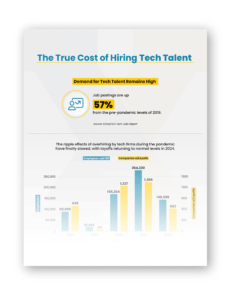As the IT Talent Gap Intensifies, Nearshoring Helps CIOs Build Highly Skilled Team
Of all the issues CIOs face, the nation’s severe IT labor shortage is what keeps them up at night.
Recruiting and retaining skilled IT staff is more important than ever, as technology that can accommodate changing consumer behavior and protect against future disruptions becomes vital to business strategy.
But nearly 60% of tech executives rank finding qualified staff as their biggest concern, even more than supply chain issues and cybersecurity threats, according to a CNBC report. Gartner predicts that the IT talent gap could cause 75% of organizations to experience visible business disruptions.
With no short-term solution in sight, nearly 50% of IT leaders have turned to outsourcing as a reliable, cost-effective means of accessing the highly skilled tech talent they need to drive agility, innovation, and growth.
Unfilled jobs vs. qualified talent: the widening IT talent gap in the U.S.
Even before COVID challenges accelerated digital transformation efforts, 2020 began with nearly 918,000 tech jobs unfilled in the U.S. – and millions in lost productivity, The Wall Street Journal reports.
And despite the lack of qualified candidates, IT job growth has reached record territory in 2021 – making it even harder to fill roles.
As of Oct. 31 – with two months of hiring left – the IT sector had added 189,000 new positions this year, Computerworld reports. The industry’s previous peak: 112,500 new IT roles in 2015.
While the national unemployment rate stood at 4.6% in October, the tech unemployment rate was 2.1%, Computerworld reports.
Making matters worse, the U.S. only graduates about 65,000 computer science students per year – not nearly enough to alleviate the shortage.
Travel embargos, limited access to educational loans, and processing delays for student visas also have combined to drop pandemic-era enrollments by 43% for international students, who generally comprise more than a quarter of computer science graduates in the U.S.
In a job market that already struggles to meet surging demand for tech talent, the shrinking talent pool threatens to constrain productivity and innovation for at least the next several years. According to the Communications of the ACM journal, hard-to-fill job vacancies reduce IT productivity levels by 65%. Unfilled vacancies slash productivity by 75%.
IT labor shortage costs companies a premium
Not surprisingly, recruiting and retaining qualified IT talent in-house is costing companies a premium. While the pandemic halted pay raises for many sectors, tech salaries rose 3.6% in 2020 and were expected to increase more this year, states the Dice 2021 Tech Salary Report.
Sought-after developers and engineers can fetch annual salaries of $200,000, according to the WSJ report. Many companies further sweeten the pot with six-figure bonuses, outsize equity stakes, and other pricey perks.
Retention is another top-of-mind concern for IT leaders. CNBC reports that an alarming 72% of tech workers are considering quitting their jobs in the next 12 months – seizing the unprecedented opportunity for higher wages, career growth opportunities, better benefits, or less-overwhelming workloads at other companies.
Even before the pandemic, the tech industry suffered a churn rate of 13.2% – the highest of any sector. Now, turnover has reached a whopping 42% for in-demand skillsets like cloud computing
The extreme turnover comes at a hefty price: Replacing technical positions costs companies an average 100-150% of salary in the tight job market.
Top nearshore locations mitigate the IT talent gap by investing heavily in tech talent
.jpg)
Over the next 10 years, the Bureau of Labor Statistics (BLS) predicts a 22% growth rate for in-demand IT roles like software developers.
Nearly 70% of tech executives said they’ve increased their hiring of remote workers to get the talent they need, CNBC reports. But even so, the U.S. job market can’t keep up – producing less qualified talent even as demand explodes and labor costs soar sky-high.
Developing enough skilled workers to close a 1-million-job gap takes time enterprises don’t have as they scramble to compete in today’s fast-changing business environment. Instead, forward-thinking IT leaders are realizing that overcoming the IT labor shortage requires a new and open-minded approach – stepping outside traditional comfort zones to explore innovative alternatives like nearshore outsourcing.
As increasing comfort and necessity pushes IT leaders to embrace remote hiring, exceptional nearshore partners offer a better solution: a one-stop source of proven resources that serve as an extension of your in-house team.
Outsourcing to top nearshore locations in Latin America like Costa Rica and Colombia enables IT leaders to tap a deep pool of exceptionally skilled, experienced talent for a fraction of the cost of hiring similar resources in the U.S.
Many nearshore locations have invested heavily into becoming technology hubs and developing tech talent. For instance, Costa Rica is so proficient in tech it’s been recognized as the Silicon Valley of Latin America. More than 350 multinational organizations maintain operations in the country, including tech giants like Intel, IBM, Microsoft, and Amazon Web Services
The deep pool of highly skilled, multilingual talent further combines with Latin America’s less competitive labor market to make it easier for providers to recruit top talent for every shift, delivering a proven track record of best-in-class, 24×7 support.
Get ahead of the IT talent gap with nearshore outsourcing
For most enterprises, COVID accelerated the need to prioritize digital transformation by months or even years. But Gartner asserts that the IT labor shortage stands as the biggest adoption barrier to 64% of emerging technologies
In 2020, CIOs dedicated an average 13.6% of their total budget to outsourced IT support, up from 9.4% in 2018. And the 2020 Global Managed Services Report found that 45% of global corporations planned to outsource even more IT work in the next 18 months.
Outsourcing to a reputable nearshore IT provider helps companies beat the labor shortfall – providing instant access to highly skilled tech talent that can drive resiliency and innovation while significantly reducing out-of-control labor costs.



